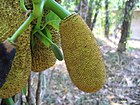Note: This is a project under development. The articles on this wiki are just being initiated and broadly incomplete. You can Help creating new pages.
Artocarpus heterophyllus - Panasa, Jackfruit
Panasa is a very important multipurpose tree. It is particularly valued for its fruit. The tree is widely cultivated in tropical regions, especially southeast Asia and Brazil.
Contents
- 1 Uses
- 2 Parts Used
- 3 Chemical Composition
- 4 Common names
- 5 Properties
- 6 Habit
- 7 Identification
- 8 List of Ayurvedic medicine in which the herb is used
- 9 Where to get the saplings
- 10 Mode of Propagation
- 11 How to plant/cultivate
- 12 Commonly seen growing in areas
- 13 Photo Gallery
- 14 References
- 15 External Links
Uses
Wound healing, Inflammation, Skin diseases, Ulcers, Bleeding [1]
Parts Used
Bark, Leaves, Heartwood, Seeds
Chemical Composition
Common names
| Language | Common name |
|---|---|
| Kannada | Halasina hannu |
| Hindi | Kathal |
| Malayalam | Plavu, Chakka |
| Tamil | Palamaram |
| Telugu | Panasa |
| Marathi | NA |
| Gujarathi | NA |
| Punjabi | NA |
| Kashmiri | NA |
| Sanskrit | Apuspaphala, Kantakiphala, Panasa |
| English | Jackfruit |
Properties
Reference: Dravya - Substance, Rasa - Taste, Guna - Qualities, Veerya - Potency, Vipaka - Post-digesion effect, Karma - Pharmacological activity, Prabhava - Therepeutics.
Dravya
Rasa
Madhura (Sweet), Kashaya (Astringent)
Guna
Guru (Heavy), Snigdha (Slimy)
Veerya
Sheeta (cold)
Vipaka
Madhura (Sweet)
Karma
Pitta, Vata
Prabhava
Habit
Identification
Leaf
| Kind | Shape | Feature |
|---|---|---|
| Simple | Alternate | 8-23 x 3-13 cm, obovate, obovate-oblong, or elliptic-ovate, apex acute or obtuse, base acute, round or cuneate, margin entire, glabrous and shining above and scabrous beneath; lateral nerves 6-8 pairs, pinnate, prominent, arched, intercostae scalariform, prominent; stipules 3-5 cm long, lateral, ovate-lanceolate, sheathing, glabrous, cauducous; petiole 20-40 mm long, stout, grooved above, glabrous. |
Flower
| Type | Size | Color and composition | Stamen | More information |
|---|---|---|---|---|
| Unisexual | Spikes | Greenish yellow | 1 | Male from young branches, catkin narrow-cylindric; perianth 2-lobed, puberulous; stamen 1; filament somewhat flattened, stout; anthers ovate-oblong; female catkins from the trunk and mature branches, more massive, perianth with strongly projecting conical apex; ovary 0.3 mm, superior, globose-obovoid; style exserted; stigma spathulate. |
Fruit
| Type | Size | Mass | Appearance | Seeds | More information |
|---|---|---|---|---|---|
| Sorosis | 30-45 x 20-25 cm | Oblong, tuberculate, tubercles conical yellowish-green, fruiting perianth yellow to light orange, fleshy | Seeds 10-12 x 8-10 mm, elliptic-oblong, smooth, glossy. | {{{6}}} |
Other features
List of Ayurvedic medicine in which the herb is used
Where to get the saplings
Mode of Propagation
How to plant/cultivate
Seed - under suitable conditions, germination begins within 10 days, and 80-100% germination is achieved within 35-40 days after sowing. The seed quickly loses viability and so should be sown as soon as possible. Seedlings produce a long taproot and can be difficult to transplant, so it is best to pot them up into deep pots as soon as they are large enough to handle and to plant them out into their permanent positions as soon as possible. The seed germinates best at a temperature of 24 - 27c. Root cuttings. Air layering. [4]
Commonly seen growing in areas
Tropical area, Sub tropical area
Photo Gallery
References
External Links
- Ayurvedic Herbs known to be helpful to treat Wound healing
- Ayurvedic Herbs known to be helpful to treat Inflammation
- Ayurvedic Herbs known to be helpful to treat Skin diseases
- Ayurvedic Herbs known to be helpful to treat Ulcers
- Ayurvedic Herbs known to be helpful to treat Bleeding
- Herbs with Bark used in medicine
- Herbs with Leaves used in medicine
- Herbs with Heartwood used in medicine
- Herbs with Seeds used in medicine
- Herbs with common name in Kannada
- Herbs with common name in Hindi
- Herbs with common name in Malayalam
- Herbs with common name in Tamil
- Herbs with common name in Telugu
- Herbs with common name in Sanskrit
- Herbs with common name in English
- Habit - Tree
- Index of Plants which can be propagated by Seeds
- Index of Plants which can be propagated by Cuttings
- Herbs that are commonly seen in the region of Tropical area
- Herbs that are commonly seen in the region of Sub tropical area
- Herbs
- Moraceae





